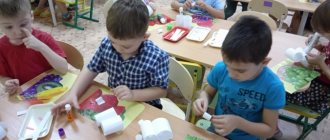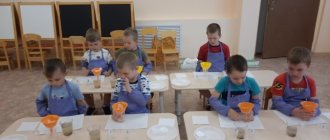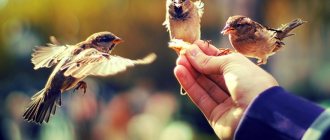History of the fishery
The industry arose in the middle of the 18th century in the Urals, where the largest number of metallurgical plants were concentrated. In the 19th century, trays began to be actively produced in the villages of the Moscow province - Zhostovo and Novoseltsev. Soon the local fishery gained enormous popularity.
Beginning in 1920, quite powerful labor artels began to form in different towns. However, ten years later, folk crafts tried to supplant Soviet ideas that suggested the establishment of realism.
Only in the 1960s. artistic painting regained its impressive authority. Leading masters created not only bright and original compositions, but also captivated with their special flavor and genuine exclusivity.
Lesson “Introduction to the Zhostovo craft in the middle group”
Minnulina Almira Rasikhovna
Lesson “Introduction to Zhostovo craft in the middle group”
Lesson “ Introduction to Zhostovo craft in the middle group ”
Purpose: to introduce the decorative art of Zhostovo craft ; consider, highlight characteristic elements; Develop artistic taste.
Teaching methods: examination, examination of samples, verbal, practical.
Materials: trays, audio recording of the Russian folk song “There was a birch tree in the field”
, tray stencils, gouache, brushes No. 2,3,5
Colors of Zhostovo painting
The classic presentation of the picture assumes a black or red background. More progressive modern concepts also allow the use of delicate pastel canvases to create a rich multi-color composition.
The Zhostovo factory produces products with a red, blue, green or light blue background. One of the most popular shades is “ivory”. Less common are “gold” and “aggressive” red canvases.
Canvases with a mother-of-pearl coating look especially elegant. Shimmers can “decorate” both the entire background and individual accents of the composition. Mother of pearl inlay was originally used in Fedoskino.
Primary colors
The color palette used by the masters of Zhostovo art is more than diverse and rich.
The following colors are preferred for the background:
- Black(#000000);
- Ivory or wheat (#F5DEB3);
- Red(#FF0000);
- Blue (#00BFFF);
- Azure (#007FFF);
- Yellow(#FFBA00);
- Burgundy (#900020);
- Gold (#FFD700);
- Amber (#FFBF00);
- Brown (#964B00).
To create the drawing itself, you can use absolutely any color. Improvisation with tones and halftones is encouraged.
Required materials and tools
To create a drawing similar to Zhostovo painting, you will need the following materials and tools:
- paints, for such painting it is best to use gouache;
- colored paper or cardboard in black, green or blue; if you don’t have anything suitable at hand, you can take plain paper and tint it with the indicated colors;
- brushes numbered 2, 4, 5, it is recommended to use kolinsky or squirrel brushes, as they help best draw small details of the composition;
- container with clean water;
- a piece of cloth to wipe brushes;
- cotton buds;
- palette.
Elements and patterns of Zhostovo painting
Most often, Zhostovo artists create simple flower arrangements in the form of bouquets. The pattern is formed from harmoniously connected small flowers and large spectacular inflorescences, unopened buds and green foliage.
Popular flowers: rose, aster, peony, tulips, dahlias, complemented by thin leaves, buds and stems with small branches. In addition to garden compositions, artists often depict modest violets, cute lilies of the valley, touching pansies or bindweed.
Along with traditional lilies, immortelle, thyme and daisies, artists loved to depict completely unprecedented outlandish flowers that do not exist in nature. Particularly rich bouquets are complemented with fruits and berries. Sometimes butterflies and birds may be depicted in the center or in the background.
(Zhostovo painting with a plot picture)
In addition to flower arrangements, Zhostovo artists sometimes painted narrative paintings. These are scenes from the lives of ordinary people, various landscapes, luxurious landscape compositions. A popular motif is a trio of horses surrounded by flowers.
The main feature of painting is an improvisational approach to any drawings. Artists are not at all obliged to create according to strict templates and images, or to follow special patterns or nature. Given the amazing variety of artistic techniques, improvisational base and creative approach, each drawing is truly unique and inimitable.
Project “Introducing children to Zhostovo craft”
Oksana Ignatova
Project “Introducing children to the Zhostovo craft”
Project
«Introducing children to Zhostovo craft»
Author: Ignatova Oksana Evgenievna
Project type : educational and creative project .
Type of project : short-term.
Participants: pre-school group (6-7 years old)
In our turbulent times, full of contradictions and anxieties, when the words “violence”
, immorality, lack of spirituality, we are seriously thinking about how today’s preschoolers will grow up.
Will we not get in their person a “lost generation”
that has no moral values? What should we, teachers, do to prevent this from happening?
I think the solution is to teach children kindness , patience, and the ability to help others from a very early age, that is, to cultivate in them those moral qualities that many adults today lack.
They say that if there is kindness, sensitivity, integrity, then a person has succeeded. The question is how, by what methods, to cultivate morality in them.
It was decided to introduce children to Russian folk traditions in order to educate them on the history of our people. And for this there is no better way than to introduce children to Russian folk crafts , the skills of folk craftsmen and Russian folklore. This will allow our children to feel part of the Russian people, to feel pride in their country, rich in glorious traditions.
Goal: to introduce the Zhostovo craft , as well as the history of our people and the skill of folk craftsmen.
1 To form a spiritual and moral attitude and feelings of belonging to the cultural heritage of one’s people through familiarization with folk traditions: (oral folk art, musical folklore, decorative and applied arts).
2. To cultivate in children emotional responsiveness and interest in examples of Russian arts and crafts.
3.Form generalized knowledge and skills:
— The ability to distinguish Zhostovo trays from other objects of decorative and applied art
— Children’s mastery of elements, color, composition.
— Ability to create expressive patterns on paper; cultivating a sense of form, rhythm, and symmetry.
4. Develop artistic and creative abilities in the process of becoming familiar with works of decorative art
The conditions for the most effective solution of problems were:
— An integrated approach to organizing classes
— Knowledge of the history of Russian folk crafts
— Thematic structure of the material.
— Children’s choice of visual material
Research methods: theoretical method: study of literature, Internet resources
Methods of working with children:
game technique (bringing in trays, creating a tea party plot)
creating a problematic situation;
organization of the work itself: sitting at tables;
positive assessment of children's work;
the connection between examining the products of folk craftsmen and the subsequent drawing up of patterns; comparison of two pattern elements;
using hand movement in the air;
exercise at the beginning of the lesson;
naming the elements of the pattern, actions when reproducing it;
leisurely pace of class,
allowing the child to think about the answer; children’s activity is facilitated by correct dialogue (the question is asked to everyone; the respondent is instructed to speak loudly, clearly, clearly; an individual approach is taken to children with a low level of speech development; everyone is involved in monitoring the respondent’s speech, addition of answers);
assessment questions (What do you like)
; indirect techniques: reminder, advice, hint, correction, remark, remark.
Expected result: children will be able to find and name Zhostovo trays , talk about the method of making trays, elements of painting, and draw the simplest elements of Zhostovo painting .
1. preparatory Develop a project , create organizational conditions for the positive organization of the project .
- study methodological literature, work experience,
- visiting sites to accumulate material on the topic of the project .
-development of a didactic exercise “How trays are made”
»
- toning paper and cutting out silhouettes of trays of different shapes
-preparation of the background (silhouette of a large tray)
for the final group work.
2. the main provision of children with the opportunity to implement acquired knowledge when performing work
-examination of illustrations, re-productions, exhibits, albums, books
2. practical work with children.
-Introduce the history of the fishery .
-Introduction to the types and shapes of flowers in Zhostovo painting
-creating conditions for creative interaction
-Deepening children’s on the topic of future work
-Formation of bright artistic images in children
Children can independently depict the simplest elements of painting (flowers)
Summing up the work done to implement the project
-Designing children's work.
-organization of exhibitions for children and parents .
Analysis of children's works.
Showing interest in folk culture.
Attached files:
Mini-project “Introducing children to the image of a letter” Mini-project “Introducing children to the image of a letter” Relevance: The relevance of the chosen topic is due to the fact that among preschool children with speech.
Project "Grandma's Tales". We introduce children to the riches of Russian fiction through familiarization with fairy tales. Children have stopped reading. TV, video, computer absorb the child, conquering the reserved corners of his consciousness and soul. V. Sukhomlinsky.
Project for the second junior group “Introducing children to the finger theater “Five Friends”” Abstract of the project: this project is designed for children 3-4 years old. Conducted with the aim of studying finger play. Provides: 1) study of a fairy tale.
Cognitive development project “Introduction to the digital laboratory of Naurash” for children of the senior group Project type: information-practice-oriented, long-term. Project participants: teachers, children, parents. Project goal: creation.
Project in the second junior group “Introducing children to Russian folk culture” Project topic: “Introducing children to Russian folk culture” Type of project: short-term Duration: from 02/04/2019 until 02/08/2019
Project: “Introducing children to Russian folk art” “Introducing children to Russian folk art.” Prepared by: Natalya Sergeevna Danilova Relevance of the topic: “Education created by ourselves.
Project “Acquaintance with Space” Municipal budgetary preschool educational institution PGO “Kindergarten No. 53” Project “Acquaintance with Space” Senior group Educator.
Project “Getting to know the writers” Project “Getting to know the writers” Anna MOROZ Project “Getting to know the writers” Middle group project Theme “Getting to know the works of writers”.
Mid-term project “Introducing children to the properties of water” 1. Goals, objectives of the project Project goals: to introduce children to the properties of water, to bring them to the understanding that plants cannot live without water.
Lesson “Introduction to Zhostovo craft in the middle group” Lesson “Introduction to Zhostovo craft in the middle group” Purpose: to introduce the decorative art of Zhostovo craft; consider,.
Source
Execution technique
Traditional painting involves the use of exclusively black canvas. Trays made of metal and wood of various shapes were used for fishing: from standard rectangular to complex combined ones.
Let's look at the whole process step by step:
Primer
At the primary priming stage, the products are treated with a special putty material and sanded. It is now that the master selects the background for the base, which will then be impossible to change.
Zamalenok
This is the basis of the ornament. Using diluted paint, the master forms the silhouettes of all the elements that will be present in the drawing. At this stage, the improvisational component is almost completely absent, and the basis for the future ornament is set strictly according to a pre-thought-out scheme.
Tenezhka
The shade allows you to give a translucent composition greater realism. Distinct shadows, “highlights” of light and halftones appear. Flowers become voluminous, leaves and stems look more natural.
Pad
This is the most critical stage. The interlining layer allows you to give the bouquet the utmost degree of realism, which distinguishes Zhostovo painting from other artistic crafts. The artist’s task is to “clarify” details and highlight individual areas. The master sets the tone of contrast or “evens out” the compositions through harmonious transitions.
Glare
Light and volume are built by superimposing highlights. The bouquet, as if exposed to the rays of the sun, begins to glow and shine. Now the composition has a special flavor and mood.
Drawing
This is a very interesting stage. The master’s task is to draw each element of the picture using a thin brush and a minimum quantity, adding realism to it. Seeds appear on the berries, pistils and stamens appear in the flower cups, leaves, grass and stems become voluminous and believable due to lacy additions and other complex accents.
(The main stages of painting in a visual drawing)
And then…
Binding
At this stage, a complex composition must be “implanted” into the background. To do this, the master uses thin blades of grass, tendrils, and ornate elements, which add even more volume to the canvas and make the entire composition whole and complete.
In order for the product to look finished and the style to fully comply with generally accepted canons, craftsmen resort to “cleaning”. This is the decoration of the side of the tray with various geometric lines, floral patterns, and floral wreaths. The edging can be very modest, only slightly emphasizing the frame, or very rich, not inferior in its splendor to the central figures of the composition.
Making a tray
The famous trays are made from sheet iron, forging is carried out on mechanical presses. Such possibilities are associated with the modern stage of tray manufacturing. Presses can give products any shape.
Popular manufacturing forms: round, oval, guitar, octagonal, rectangular (Siberian), winged and combined.
How to make forged trays:
- Using hand scissors, the master cuts out a bracket of 3-5 metal cards;
- Using a hammer and anvil, the master knocks out and stretches the shape;
- the edge of the tray is rolled up, and to make the product stronger, a wire insert is placed in it;
- The craftsman smoothes the edge with a hammer.
Then the artists begin painting. Its plot will always be exclusive. Each factory forged tray has a special number, and the quality of the product will be confirmed by a certificate.
If the tray is made using a stamp and molds, then the master has 32 molds in his arsenal (starting with A1, and then ascending). Trays of standard shape are also hand-painted. Sheets of metal are first cut into pieces of the required size, then the product is cut and drawn out using an electric press, and then the edges are rolled up.
The tray blank is prepared according to painting
Next comes an equally difficult stage - preparation for painting. And today the famous Zhostovo trays are made according to an established algorithm: annealing, degreasing, priming, applying rough enamel in several layers (each layer should be dried). And only after subsequent cleaning begins the painting itself.
Unfortunately, cases of counterfeit Zhostovo tray are not uncommon. The original will always be weighty and will not bend if you place heavy dishes on it. And real trays are mirrored, so you can easily see your own reflection in them. Curved lines and unclear drawing on originals are also impossible.
Stages of creating a drawing
Stages of creating a Zhostovo tray:
- Painting. Choose a theme for the composition and create sketches of the bouquet.
- Tenezhka. They cast shadows and give volume to flowers.
- Pad. All elements of the composition are carefully written out.
- Glare. There are highlights on all the details. The effect of illumination of the bouquet is created. Thanks to this, the flowers gain volume.
- Drawing. To perform this step, use a brush. Thanks to this painting, the flowers look like real ones. The master makes veins on the leaves, draws seeds and other plant details.
- Binding. Using stems and leaves, the bouquet is assembled into a single composition.
- Cleaning the edges. This is the final stage of tray design. The sides of the product are decorated with various ornaments.
This is a complex painting technique that is used only by professionals. For beginners, it is best to first master simple pictures made on sheets of paper.





